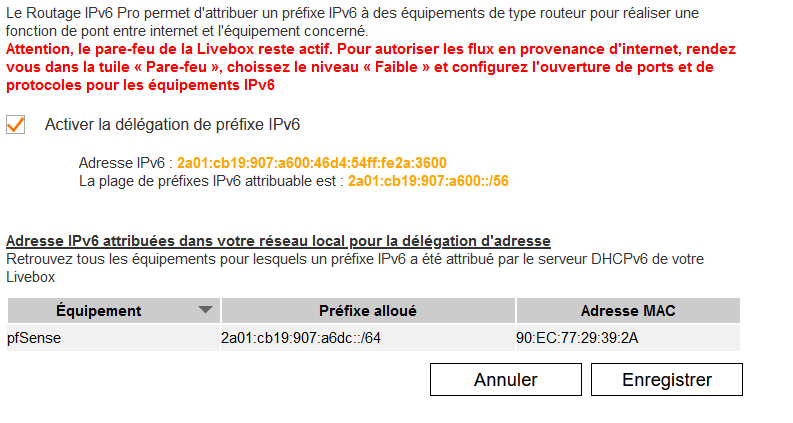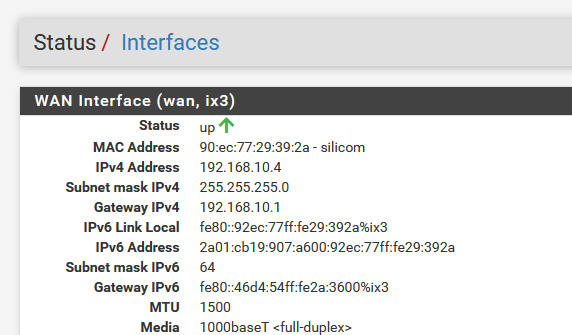prefix length should be 64
-
-
@gregeeh said in prefix length should be 64:
@JKnott has previously suggested I should not disable Use IPv4 connectivity as parent interface.
Same thing for me.
I have to disable = uncheck that option. If checked it : no more IPv6.(my) Long story short :
My ISP router :

What I make of this : My ISP has a 2a01:cb19:907:a600::/56 for me.
It uses the first '00' prefix for the ISP router LAN : 2a01:cb19:907:a600:46d4:54ff:fe2a:3600The 90:EC:77:29:39:2A is that MAC of my pfSense WAN :
My pfSense IPv6 WAN interface :

The stupid thing is : whatever I do, my ISP router communicates just one prefix, the 'a6dc' for pfSense. Not the a601, or a6ff, only 'dc', so I can only use IPv6 on my pfsense LAN, and no Ipv6 on others LANs, as I need more prefixes for that.
dhcp6c logs on pfSense show me that It asks for more (I've used a hand crafted dhcp6c config file to do so) but that was a no-go.
And its gets way better : the IPv6 firewall on the ISP router does not permit me to create pass rules for IPv6 addresses or network using the prefix it handed over to pfSense.
These issues are known on the french support forum .... -
@gregeeh said in prefix length should be 64:
This RA submit has me confused, as does it not depend on what IPv6 my ISP gives me and if so what happens if the IPv6 changes. Just all confused about this.
It is normal to use 'what IPv6 my ISP gives' in the land of IPv6. The ISP should provide a reserved /48 block for you and this should not change. Technically you could set this block without DHCPv6 but it would be unwise and not generally recommended.
There is always a sideways look at an RFC 'should' statement and, as you have been already been exposed to, many ISPs assign a /56 (giving you a smaller block to work with) as this option was given some formal weight by the later RFC6177. Nobody likes a nibble.
I also hear stories of some US ISPs providing a daft /64 block. There is no excuse for this as there are enough /48 for everything and everyone.
 ️
️ -
A /48 is 65535 prefixes, or 65535 LANs using 2^64 IPs for every LAN, right ?
A /56 is 'just' 255 LANs for the end user.The typical SOHO Internet connection : I wonder what needs to be invented so that 255*(2^^64) isn't enough anymore

-
@Gertjan said in prefix length should be 64:
my ISP router communicates just one prefix
Technically you could use that for NPt.
-
@Gertjan said in prefix length should be 64:
@RobbieTT
A /56 is 'just' 255 LANs for the end user.The typical SOHO Internet connection : I wonder what needs to be invented so that 255*(2^^64) isn't enough anymore

It's that kind of presumption that brought about the folly of the revised RFC that made an unsupported leap of 'IPv6 address exhaustion' and worked backwards to the idea that a new measure of IPv4-esq address conservation was needed that the original IPv6 designers must have missed with their /48 per site recommendation.
This turned the original logic of the IPv6 design on its head. The underlying maths even managed to forget that almost all the GUA beyond the (then) original
2001:block was held in reserve!This is an old article on the subject but it encapsulates my thoughts to this day:
More importantly it leads to this situation:
@Gertjan said in prefix length should be 64:
What I make of this : My ISP has a 2a01:cb19:907:a600::/56 for me.
It uses the first '00' prefix for the ISP router LAN : 2a01:cb19:907:a600:46d4:54ff:fe2a:3600
The stupid thing is : whatever I do, my ISP router communicates just one prefix, the 'a6dc' for pfSense. Not the a601, or a6ff, only 'dc', so I can only use IPv6 on my pfsense LAN, and no Ipv6 on others LANs, as I need more prefixes for that.
Which is you struggling to get beyond a single subnet with the slightly more confusing /56 block and the less distinct nibble boundaries, in the more readable hex format, that is representing a long binary address.
So you may think a /56 is more than adequate for the decades to come, yet you yourself are struggling to get beyond a single subnet. You are not exactly a good advert for the merits of a /56 or the perils of the nibble boundaries. This IPv6 stuff is supposed to be understandable by every connected household, a limitation that the original IPv6 designers did understand.

(Hint: 2a01:cb19:907:a6 is the bounded nibble for your /56 prefix)
 ️
️ -
I see you have the MTU set on the WAN. It won't hurt anything unless you're on ADSL or other connection that requires a less than 1500 MTU, but it's not needed.
I also see you're using prefix ID 3, which explains why the packet capture shows :2903 for the LAN prefix. That's fine.
Why do you have question marks next to the gateway? Using link local addresses for routing is entirely normal.
On RA, why do you have stateless? That implies you're using DHCP6, but you don't have it enabled. I use unmanaged here. -
@Bob-Dig said in prefix length should be 64:
@gregeeh Again it is ISP specific, @JKnott can't know everything, it is on you to try those options.
If his ISP is using DHCPv6-PD, and it appears they are, that parent interface is required. DHCPv6-PD won't work properly without it.
-
@Gertjan said in prefix length should be 64:
A /56 is 'just' 255 LANs for the end user.
256, not 255.
-
@RobbieTT said in prefix length should be 64:
It's that kind of presumption that brought about the folly of the revised RFC that made an unsupported leap of 'IPv6 address exhaustion' and worked backwards to the idea that a new measure of IPv4-esq address conservation was needed that the original IPv6 designers must have missed with their /48 per site recommendation.
There are only enough /48s to give a bit over 4000 to every single person on the planet. We'd better not waste them.

-
@JKnott said in prefix length should be 64:
There are only enough /48s to give a bit over 4000 to every single person on the planet. We'd better not waste them.

But that may impinge of the plan to give each grain of sand on the planet 45 quintillion unique IPv6 addresses.
Tough choices ahead, so I need to get the kettle on, which has its own /64 already!
🫖
-
@RobbieTT said in prefix length should be 64:
It's that kind of presumption ....
Humm, no, didn't want to presuming anything - I was just mentioning what I have - and what I see.
And of course /56 won't be enough. But I'll sign for it@RobbieTT said in prefix length should be 64:
Bad IPv6 Address Management
 Nice, that was written 11 years ago, and still very valid today.
Nice, that was written 11 years ago, and still very valid today.Btw : I'm not a IPv6 designer, just a guy using pFsense and I can tap into the "IPv6 resource" made available by my ISP. Learning while doing, of course.
-
Sorry @all for hijacking this thread with a short question...
My German provider gives me a /56 prefix. It is no /48 but reading here regularly, I guess my /56 is close to heaven. ;)I set WAN on pfsense (which is behind a Fritzbox handing out everything) as DHCPv6 with a /57 prefix delegation size.
Why I did that? For once, cause both tutorials I found for a setting like that told me to :D and cause Fritzbox is using own /64s for its LAN and guest LAN out of the ISPs /56.
Everything works, all seems to be fine. VLANs get their own /64 with their own subnet part and SLAAC, clients get ULA, GUA, even changing GUAs (by ISP) don't bother me much...although..no, it does bother me, but it works for now...So, just a theoretical question (I hope since everything works and I haven't noticed any flaws): is that the way to do it or is it bogus and I could go with /56 on pfsense's WAN delegation size?
-
@JKnott said in prefix length should be 64:
On RA, why do you have stateless? That implies you're using DHCP6, but you don't have it enabled. I use unmanaged here.
Changed to unmanaged and now all seems good.
Only issue is DHCP6 Gateway is pending.



-
@gregeeh said in prefix length should be 64:
Only issue is DHCP6 Gateway is pending.
That could be due to what you're pinging. While you can ping a link local address, your ISP might not have configured it to respond. That's the case with my ISP. What I did was run a traceroute to Google and picked the first global address to use for the monitor.
-
@JKnott said in prefix length should be 64:
That could be due to what you're pinging.
I can ping the same addess from the pfSense CLI, so should it not also work in the Gateway Monitoring.
-
You'd think so. Did you enter the address for the gateway? Or just leave the box blank. It will default to the gateway address, so you don't have to enter anything. You could try putting some working GUA, that you can ping, in that box.
-
@JKnott said in prefix length should be 64:
Did you enter the address for the gateway?
Gateway is set to dynamic and cannot be changed.
@JKnott said in prefix length should be 64:
You could try putting some working GUA, that you can ping, in that box
Sorry, I do not know how to do that.
-
First, go to a command prompt in pfSense and traceroute6 go Google:
traceroute6 google.com
traceroute6 to google.com (2607:f8b0:400b:807::200e) from 2607:f798:804:90:3899:8d05:91dc:56e3, 64 hops max, 28 byte packets
1 * * *
2 2607:f798:10:10d3:0:241:5615:221 11.193 ms 14.659 ms 10.508 ms
3 2607:f798:10:2f0:0:2091:4823:2041 13.284 ms 11.321 ms 11.772 ms
4 2607:f798:10:359:0:2091:4823:5210 9.483 ms 25.759 ms 10.510 ms
5 2607:f798:14:83::2 9.943 ms 10.558 ms 9.958 ms
6 2001:4860::1c:4001:57f0 12.773 ms
2001:4860:0:17::1 11.295 ms *
7 2001:4860:0:1::5b65 9.855 ms
2001:4860:0:1::5b67 18.374 ms 9.626 ms
8 yyz12s07-in-x0e.1e100.net 13.584 ms 11.359 ms 15.533 msThen ping6 the address in line 2 to see if it works:
ping6 2607:f798:10:10d3:0:241:5615:221
PING6(56=40+8+8 bytes) 2607:f798:804:90:3899:8d05:91dc:56e3 --> 2607:f798:10:10d3:0:241:5615:221
16 bytes from 2607:f798:10:10d3:0:241:5615:221, icmp_seq=0 hlim=63 time=12.287 ms
16 bytes from 2607:f798:10:10d3:0:241:5615:221, icmp_seq=1 hlim=63 time=12.629 ms
16 bytes from 2607:f798:10:10d3:0:241:5615:221, icmp_seq=2 hlim=63 time=12.441 msIt does, so that address can be pasted into the monitor address box.
-
@JKnott - Here's the result from the CLI:
[2.7.0-RELEASE][admin@pfSense.localdomain]/root: traceroute6 google.com traceroute6 to google.com (2404:6800:4006:810::200e) from 2402:7940:f021:2903:2e0:4cff:fe68:1bb3, 64 hops max, 28 byte packets 1 2402:2c80:1:10::22 6.017 ms 6.062 ms 5.908 ms 2 2402:7940::1 5.770 ms 6.202 ms 6.044 ms 3 2001:4860:1:1::1834 5.860 ms 6.638 ms 5.888 ms 4 2001:4860:0:110a::1 5.740 ms 6.116 ms * 5 2001:4860:0:1::4245 7.022 ms 7.684 ms 2001:4860:0:1::4247 7.669 ms 6 syd15s15-in-x0e.1e100.net 5.926 ms 6.056 ms 5.861 ms [2.7.0-RELEASE][admin@pfSense.localdomain]/root: ping6 2402:7940::1 PING6(56=40+8+8 bytes) 2402:7940:f021:2903:2e0:4cff:fe68:1bb3 --> 2402:7940::1 16 bytes from 2402:7940::1, icmp_seq=0 hlim=63 time=6.321 ms 16 bytes from 2402:7940::1, icmp_seq=1 hlim=63 time=6.061 ms 16 bytes from 2402:7940::1, icmp_seq=2 hlim=63 time=6.330 ms 16 bytes from 2402:7940::1, icmp_seq=3 hlim=63 time=5.970 ms ^C --- 2402:7940::1 ping6 statistics --- 4 packets transmitted, 4 packets received, 0.0% packet loss round-trip min/avg/max/std-dev = 5.970/6.170/6.330/0.158 ms [2.7.0-RELEASE][admin@pfSense.localdomain]/root:Still getting pending on the DHCP6 Gateway.